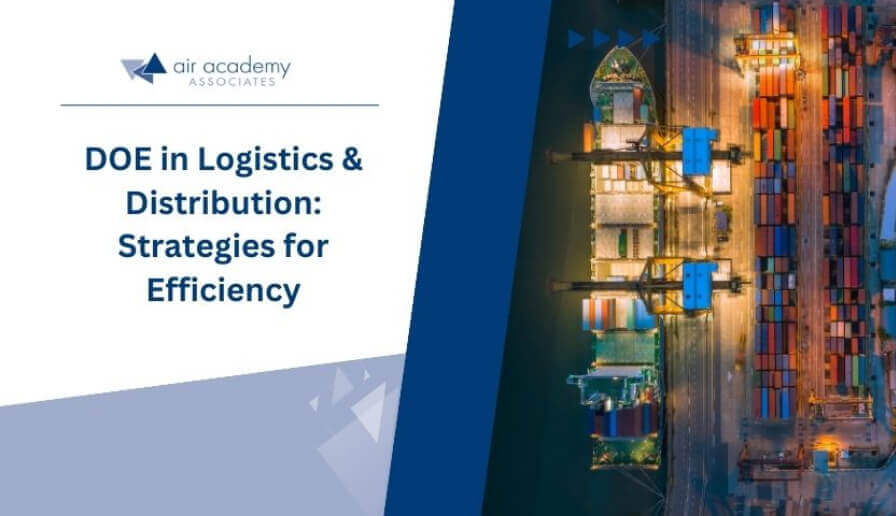
Integrating Design of Experiments (DOE) into logistics and distribution management offers a groundbreaking approach to optimizing supply chain processes. DOE, a systematic method used to determine the relationship between factors affecting a process and its output, is especially relevant in logistics and distribution operations. This method enables businesses to identify the most efficient ways to allocate resources, streamline operations, and ultimately enhance productivity and reduce costs.
For business leaders, DOE’s significance extends beyond mere operational enhancements; it is a strategic tool that fosters innovation, agility, and competitiveness in the market. Organizations can achieve operational excellence by systematically exploring and implementing DOE’s insights, supporting sustainable growth and customer satisfaction.
Let’s learn more about the impact of DOE on logistics and distribution management.
Key Takeaways
- Design of Experiments (DOE) offers a structured approach to optimize logistics and distribution processes through systematic testing and analysis.
- Implementing DOE in inventory management, warehouse optimization, and transportation strategies enhances operational efficiency and cost savings.
- DOE facilitates data-driven decision-making, enabling businesses to adapt quickly to market changes and customer demands.
- Continuous application of DOE principles ensures ongoing improvement and competitive advantage in logistics and distribution management.
Core Principles of DOE in Logistics

Image Source: Pexels
The application of Design of Experiments (DOE) in logistics and distribution management is underpinned by a series of core principles that guide the systematic investigation of processes to improve efficiency and effectiveness. Understanding these principles is crucial for leveraging DOE to its full potential in a logistics context.
Principle 1: Identifying the Variables
The first step in applying DOE is identifying the variables that could influence the outcome of logistics and distribution processes. These variables can range from operational factors like warehouse layout and inventory levels to external factors like supplier reliability and transportation routes.
The goal is to pinpoint which variables, including controllable and uncontrollable factors, impact process performance most.
Principle 2: Designing the Experiment
Once the variables are identified, the next step is designing the experiment. This involves selecting an appropriate experimental design that suits the logistics operation’s complexity and goals.
Standard designs include factorial designs, which allow the examination of multiple variables simultaneously, and fractional factorial designs, used when testing all possible variable combinations, are impractical due to resource constraints.
Principle 3: Conducting the Experiment
With the design in place, the experiment is conducted according to the predetermined plan. This could involve testing different warehouse layouts, transportation schedules, or inventory management strategies under controlled conditions to observe the effects on efficiency, cost, and service level.
Principle 4: Analyzing the Data
The data collected from the experiments are then analyzed to understand the impact of each variable on the logistics processes. Statistical analysis tools are used to discern patterns, relationships, and significant factors that dictate process outcomes. This analysis helps in identifying the optimal settings for the variables under study.
Principle 5: Implementing Improvements
The insights gained from the analysis inform decisions on process improvements. Implementing changes based on DOE findings allows logistics managers to refine operations strategically. This could mean adjusting inventory levels, redesigning distribution routes, or adopting new technologies to enhance overall supply chain performance.
Principle 6: Continuous Optimization
DOE in logistics is not a one-time event but a continuous improvement cycle. As business environments, market demands, and technologies evolve, logistics operations must be regularly reevaluated through DOE to ensure optimal performance. This principle of continuous optimization ensures that logistics and distribution management remains agile and responsive to changing conditions.
By adhering to these core principles, DOE provides a structured approach to exploring various variables affecting logistics and distribution operations. This systematic exploration enables business leaders to make informed decisions that drive efficiency, reduce costs, and improve customer satisfaction in their supply chains.
Through the strategic application of DOE, companies can address current operational challenges and proactively prepare for future demands and opportunities in the logistics sector.
Benefits of Implementing DOE in Logistics Operations

Image Source: Freepik
Adopting the Design of Experiments (DOE) within logistics and distribution management enhances operational performance and strategic planning. This systematic approach allows businesses to streamline their supply chain processes and harness significant efficiencies and cost savings.
Below, we detail the key benefits of implementing DOE in logistics operations.
Enhanced Operational Efficiency
DOE enables logistics managers to identify the most effective ways to allocate resources and streamline operations. By systematically testing different variables and their configurations, organizations can uncover optimal processes that significantly enhance throughput, reduce turnaround times, and improve overall operational efficiency.
This systematic approach ensures that every decision is backed by data, reducing guesswork and enabling precise adjustments to logistics operations.
Cost Reduction Strategies
One of the most compelling benefits of DOE is its ability to help identify strategies for cost reduction. Through the careful analysis of experimental data, logistics managers can pinpoint areas where expenses can be minimized without compromising on quality or delivery times. This includes identifying more efficient routes, better inventory management practices, and the optimal use of labor and materials. Companies can achieve substantial cost savings across their supply chain by focusing on these areas.
Improved Resource Allocation
DOE provides insights into the most effective use of resources, including workforce, machinery, and materials. By understanding the impact of various factors on logistics operations, businesses can allocate their resources more efficiently, ensuring that they are used where they have the greatest impact. This optimized allocation improves productivity and contributes to a leaner, more cost-effective operation.
Increased Adaptability to Market Changes and Customer Demands
The logistics and distribution landscape constantly evolves, changing market dynamics, customer preferences, and technology. DOE equips businesses with the agility to adapt swiftly to these changes.
By regularly employing DOE to test new hypotheses and scenarios, companies can quickly adjust their operations in response to emerging trends and customer feedback, ensuring they remain competitive and responsive.
Data-Driven Decision Making
At the heart of DOE is the principle of data-driven decision-making. By relying on empirical evidence gathered through carefully designed experiments, businesses can make informed decisions more likely to succeed. This approach minimizes the risks associated with trial-and-error methods and ensures that changes to logistics operations are both strategic and effective.
Competitive Advantage
Finally, the strategic implementation of DOE can provide companies with a significant competitive advantage. By optimizing their logistics and distribution operations, businesses can offer faster, more reliable, and cost-effective services than their competitors. This enhances customer satisfaction and loyalty and positions the company as a leader in operational excellence within its industry.
The benefits of implementing DOE in logistics operations are extensive and impactful. DOE provides a robust framework for optimizing logistics and distribution management, from enhancing operational efficiency and reducing costs to improving resource allocation and data-driven decision-making.
As businesses continue to navigate the complexities of the global supply chain, adopting DOE principles can be a key differentiator in achieving operational excellence and sustainable competitive advantage.
DOE Strategies for Logistics and Distribution Management

Image Source: Freepik
Implementing the Design of Experiments (DOE) within logistics and distribution management involves strategic planning and execution across various facets of the supply chain. By applying DOE, businesses can significantly enhance operational processes, from inventory management to warehouse operations and transportation strategies.
This section outlines the key DOE strategies for optimizing logistics and distribution management and provides examples to illustrate their application.
Inventory Management
DOE can be instrumental in optimizing inventory levels, ensuring that businesses maintain the right balance between meeting customer demand and minimizing holding costs. Through DOE, companies can experiment with different inventory models, such as Just-In-Time (JIT) inventory systems, to reduce waste and enhance responsiveness to market changes.
For instance, a retail company could use DOE to test the impact of various reorder points and order quantities on inventory costs and service levels. The company can identify the optimal inventory strategy that minimizes stockouts and reduces excess inventory by analyzing the results.
Warehouse and Storage Optimization
The layout and operations of a warehouse directly impact the efficiency of logistics and distribution processes. DOE can be used to evaluate different warehouse layouts and operational strategies to determine the most effective configurations for minimizing handling times and maximizing space utilization.
For example, a distribution center may use DOE to compare the efficiency of a traditional storage layout versus a dynamic slotting arrangement. The center can identify the design that best supports its operational goals by assessing factors such as picking speed and order accuracy.
Transportation and Delivery Management
Transportation is a critical component of logistics that significantly affects delivery times and costs. DOE can help logistics managers develop and test transportation strategies, including route optimization, mode selection, and carrier performance.

Image Source: Freepik
For instance, a logistics company might experiment with various route optimization software solutions to identify which provides the most significant reductions in delivery times and fuel consumption. Similarly, a company could use DOE to assess the cost-effectiveness and reliability of different shipping modes (e.g., air vs. ground) for various types of shipments.
Application Examples
- Route Optimization: A logistics firm experiments to determine its fleet’s most efficient delivery routes. The firm can identify the optimal routing strategy that minimizes travel time and fuel consumption by testing different routing algorithms and considering variables such as traffic patterns, delivery windows, and vehicle load capacity.
- Packaging Experiments: A company shipping fragile goods uses DOE to find the best packaging method that minimizes damage rates while controlling costs. The company can determine the most effective strategy that ensures product safety and reduces waste by varying packaging materials, box sizes, and cushioning techniques.
- Load Planning: A distribution company applies DOE to optimize its truck loading processes. By experimenting with different loading patterns, weight distributions, and space utilization techniques, the company can identify the most efficient way to load goods, reducing shipping costs and improving delivery efficiency.
These examples illustrate how DOE can be applied to various logistics and distribution management aspects to drive significant improvements. By systematically testing and analyzing different strategies, companies can make informed decisions that enhance efficiency, reduce costs, and improve service levels, ultimately gaining a competitive edge in the market.
Conclusion
The strategic application of Design of Experiments (DOE) in logistics and distribution management provides a powerful tool for businesses seeking to optimize their supply chain operations. Through the systematic investigation and analysis of different variables and strategies, DOE enables organizations to identify the most efficient and cost-effective approaches to inventory management, warehouse operations, and transportation logistics.
The benefits of implementing DOE are clear: enhanced operational efficiency, significant cost reductions, improved resource allocation, and increased adaptability to rapidly changing market conditions and customer demands. By embracing DOE, companies can improve their current logistics and distribution processes and position themselves for sustained success in a competitive global market.
The key to unlocking these advantages lies in a committed, data-driven approach to experimentation and continuous improvement, ensuring that logistics operations contribute positively to overall business objectives and customer satisfaction.
Consider enrolling in our Operational Design of Experiments Course to advance your logistics and distribution management expertise. This detailed course will equip you with the knowledge and tools to apply DOE effectively within your supply chain, enhancing efficiency and reducing costs. Gain the skills needed for informed decision-making and operational improvement. Enroll with us today!


